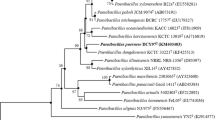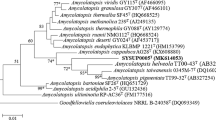Abstract
Bacterial strain WT00CT is an endophytic bacterium that was isolated from the tea plant (Camellia sinensis L.). The phylogenetic analysis of 16S rRNA genes demonstrated that strain WT00CT was a member of the genus Herbaspirillum. This strain is microaerobic, gram-negative and non-pigmented, and its cells are rod shaped, with a polar flagellum. It grew optimally at 34–37 °C, pH 5.0–8.0 and 0–1.5% NaCl (w/v). The G + C content of its genomic DNA was 62.36 mol%. C16:0, iso-C15:0, iso-C17:0, anteiso-C15:0 and anteiso-C17:0 were major fatty acids. The strain WT00CT contained six polar lipids, namely DPG (diphosphatidylglycerol), PE (phosphatidylethanolamine), PG (phosphatidylglycerol), PC (phosphatidylcholine), GL (glycolipid) and APL (aminophospholipids), and its respiratory quinone was Q8. The strain WT00CT had a genome size of 6.08 Mb with a total ORF of 5,537, in which one gene cluster (36 genes) encoding a type IV secretion system was absent in other members of the Herbaspirillum genus. ANI values of genomic comparison between the strain WT00CT and other Herbaspirillum species were 75–96%. Based on the phylogenetic, chemotaxonomic and phenotypic data presented here, the strain WT00CT represents a novel species in the Herbaspirillum genus, for which the name Herbaspirillum camelliae sp. nov. is proposed. The type strain of H. camelliae sp. nov. is WT00CT (AB 2018017 T and KCTC 62527 T).

Similar content being viewed by others
References
Baldani JI, Baldani VLD, Seldin L, Dobereiner J (1986) Characterization of Herbaspirillum seropedicae gen. nov. sp. nov. a root-associated nitrogen-fixing bacterium. Int J Syst Bacteriol 36(1):705–710
Baldani JI, Pot B, Kirchhof G, Falsen E, Baldani VL, Hoste B, Kersters K, Hartmann A, Gillis M, Döbereiner J (1996) Emended description of Herbaspirillum; inclusion of [Pseudomonas] rubrisubalbicans, a milk plant pathogen, as Herbaspirillum rubrisubalbicans comb. nov.; and classification of a group of clinical isolates (EF group 1) as Herbaspirillum species 3. Int J Syst Bacteriol 46(3):802
Chen J, Su Z, Liu Y, Sandoghchian S, Zheng D, Wang S, Xu H (2011) Herbaspirillum species: a potential pathogenic bacteria isolated from acute lymphoblastic leukemia patient. Curr Microbiol 62(1):331–333
Chen C, Tian J, Zhou J, Ni X, Lei J, Wang X (2020) Bacterial growth, morphology, and cell component changes in Herbaspirillum sp. WT00C exposed to high concentration of selenite. J Basic Microbiol 60:304–321
Cheng W, Zhan G, Liu W, Zhu R, Yu X, Li Y, Li Y, Wu W, Wang X (2017) Draft genome sequence of endophytic Herbaspirillum sp. strain WT00C, a tea plant growth-promoting bacterium. Genome Announc 5:e01719–e1816
Christopher WN, Edgerton CW (1930) Bacterial stripe diseases of sugar cane in Louisiana. J Agric Resear 41(3):259–267
Cummings MP (2004) MEGA (Molecular evolutionary genetics analysis) in dictionary of bioinformatics and computational biology. John Wiley and Sons Inc., New Jersey
Ding L, Yokota A (2004) Proposals of Curvibacter gracilis gen. nov. sp. nov. and Herbaspirillum putei sp. nov. for bacterial strains isolated from well water and reclassification of [Pseudomonas] huttiensis, [Pseudomonas] lanceolata, [Aquaspirillum] delicatum and [Aquaspirillum] autotrophicum as Herbaspirillum huttiense comb. nov., Curvibacter lanceolatus comb. nov., Curvibacter delicatus comb. nov. and Herbaspirillum autotrophicum comb. nov. Int J Syst Evol Microbiol 54(6):2223–2230
Dobritsa AP, Reddy MC, Samadpour M (2010) Reclassification of Herbaspirillum putei as a later heterotypic synonym of Herbaspirillum huttiense, with the description of H. huttiense subsp. huttiense subsp. nov. and H. huttiense subsp. putei subsp. nov. comb. nov. and description of Herbaspirillum aquaticum sp. nov. Int J Syst Evol Microbiol 60(6):1418–1426
Dong X, Cai M (2001) Determination of biochemical properties. Manual for the systematic identification of general bacteria. Beijing Scientific Press, Beijing, pp 370–398
Gerhardt P, Murray RGE, Wood WA, Krieg NR (1994) Methods for general and molecular bacteriology. American Society for Microbiology, Washington
Im WT, Bae HS, Yokota A, Lee ST (2004) Herbaspirillum chlorophenolicum sp. Nov. a 4-chlorophenol-degrading bacterium. Int J Syst Evol Microbiol 54(3):851–855
Kirchhof G, Eckert B, Stoffels M, Baldani JI, Reis VM, Hartmann A (2001) Herbaspirillum frisingense sp. Nov. a new nitrogen-fixing bacterial species that occurs in C4-fibre plants. Int J Syst Evol Microbiol 51(1):157–168
Krieg NR, Staley JT, Brown DR, Hedlund EP, Paster BJ, Ward NL, Ludwig W, Whitman WB (2010) Bergey’s manual of systematic bacteriology. Springer, New York. https://doi.org/10.1007/978-0-387-68572-4
Leifson E (1962) The bacterial flora of distilled and stored water. III new species of the genera Corynebacterium, Flavobacterium, Spirillum and Pseudomonas. Int J Syst Bacteriol 12(4):161–170
Schlegel HG (1978) Aquaspirillum autotrophicum, a new species of hydrogen oxidizing, facultatively autotrophic bacteria. Int J Syst Evol Microbiol 28(1):112–116
Valverde A, Velázquez E, Gutiérrez C, Cervantes E, Ventosa A, lqual JM (2003) Herbaspirillum lusitanum sp. nov a novel nitrogen-fixing bacterium associated with root nodules of Phaseolus vulgaris. Int J Syst Evol Microbiol 53(6):1979–1983
Wang T, Yang S, Chen Y, Hu L, Tu Q, Zhang L, Liu X, Wang X (2014) Microbiological properties of two endophytic bacteria isolated from tea (Camellia sinensis L.). Acta Microbiol Sin 54(4):424–432
Xu X, Cheng W, Liu X, You H, Wu G, Ding K, Tu X, Yang L, Wang Y, Li Y, Gu H, Wang X (2020) Selenate reduction and selenium enrichment of tea by the endophytic Herbaspirillum sp. strain WT00C. Curr Microbiol 77:588–601
Zhan G, Cheng W, Liu W, Li Y, Ding K, Rao H, Wu W, Wang X (2016) Infection, colonization and growth-promoting effects of tea plant (Camellia sinensis L) by the endophytic bacterium Herbaspirillum sp. WT00C. Afr J Agric Res 11(3):130–138
Ziga ED, Druley T, Burnham CA (2010) Herbaspirillum species bacteremia in a pediatric oncology patient. J Clin Microbiol 48(11):4320–4321
Acknowledgements
This work was supported by a grant (2016YFD0200905) from the Ministry of Science and Technology of the People’s Republic of China, and it was also assisted by an innovation-driven power program of the Hubei Association for Science and Technology, Hubei province, China.
Author information
Authors and Affiliations
Corresponding author
Additional information
Communicated by Erko Stackebrandt.
Publisher's Note
Springer Nature remains neutral with regard to jurisdictional claims in published maps and institutional affiliations.
Electronic supplementary material
Below is the link to the electronic supplementary material.
Rights and permissions
About this article
Cite this article
Liu, X., Zhou, J., Tian, J. et al. Herbaspirillum camelliae sp. nov., a novel endophytic bacterium isolated from Camellia sinensis L. Arch Microbiol 202, 1801–1807 (2020). https://doi.org/10.1007/s00203-020-01892-1
Received:
Revised:
Accepted:
Published:
Issue Date:
DOI: https://doi.org/10.1007/s00203-020-01892-1




